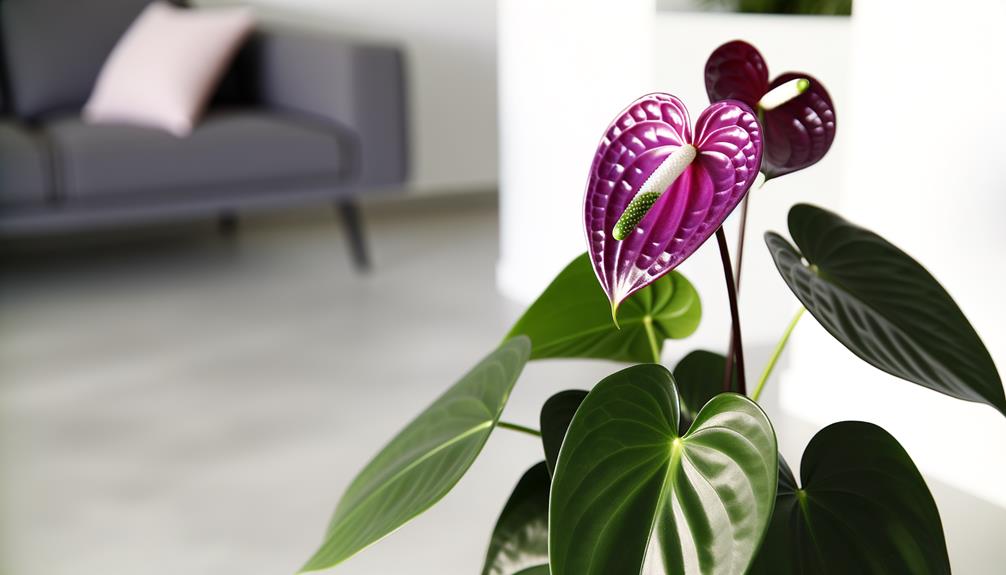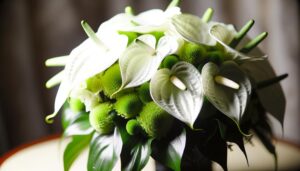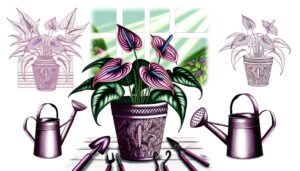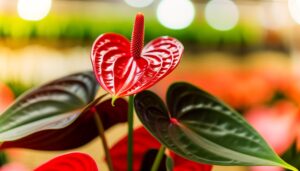Unique Indoor Plant: What Makes Anthurium Cavalli Purple Special?
The Anthurium Cavalli Purple stands out due to its striking velvety purple spathes and heart-shaped leaves with prominent veining. Originating from tropical rainforests, it thrives in well-draining, nutrient-rich soil with high humidity.
Its efficient vascular system ensures long-lasting blooms. This plant requires consistent moisture, lukewarm distilled water, and indirect bright light to prevent leaf burn.
Additionally, it purifies indoor air by removing pollutants like formaldehyde and ammonia. If you're intrigued by its unique features and ideal care conditions, you'll discover more fascinating details about this exotic species.

Key Takeaways
- Striking purple blooms with vibrant pigmentation make it visually unique.
- Heart-shaped leaves with prominent veining add to its distinctive appearance.
- Velvety purple spathes create a striking contrast against dark green foliage.
- Efficient vascular system ensures long-lasting blooms and overall plant health.
- High transpiration rate enhances indoor humidity, benefiting general air quality.
Origin of Anthurium Cavalli Purple
The Anthurium Cavalli Purple, a stunning cultivar of the Anthurium genus, originates from the tropical rainforests of Central and South America, where it thrives in the humid, shaded understory. You'll find it nestled among dense foliage, benefiting from consistent moisture and diffused light. This habitat offers nutrient-rich, well-draining soil, essential for its growth.
The plant's physiological adaptations include thick, waxy leaves that reduce water loss and aerial roots that absorb nutrients from organic matter. It flourishes in temperatures between 70-85°F, with humidity levels above 60%. Understanding its native environment helps you replicate these conditions at home, ensuring ideal growth.
This connection to its origins deepens your appreciation for its unique beauty and resilience.
Distinctive Features
You'll immediately notice the Anthurium Cavalli Purple's striking purple blooms, characterized by their vibrant pigmentation and waxy texture.
The plant's leaves exhibit a unique, heart-shaped morphology with prominent veining, contributing to its distinctive appearance.
These features not only enhance its aesthetic appeal but also indicate its specialized adaptation to tropical environments.
Striking Purple Blooms
Anthurium Cavalli Purple stands out with its vibrant, velvety purple spathes that contrast strikingly against dark green foliage, making it a visually enchanting specimen.
You'll appreciate the spathes' high anthocyanin concentration, responsible for their deep, mesmerizing hue. The spadix, a central column, often complements the spathe with a contrasting color, enhancing the plant's allure.
These blooms aren't just ornamental; they're structurally fascinating, with a waxy texture that suggests robust cellular structure and adaptability to indoor environments.
The blooms exhibit a long-lasting nature, frequently persisting for several weeks. This durability results from the plant's efficient vascular system, allowing sustained nutrient and water transport.
Such traits make Anthurium Cavalli Purple a truly exceptional addition to your indoor plant collection.
Unique Leaf Shape
Marvel at the Anthurium Cavalli Purple's distinctive foliage, which showcases a heart-shaped form with pronounced veining and a glossy, nearly mirror-like surface. You'll notice the leaves' unique venation pattern, providing structural integrity and efficient nutrient transport.
The broad, cordate (heart-shaped) leaves maximize photosynthetic efficiency, allowing for prime energy absorption. Their glossy cuticle layer reduces water loss, enhancing drought resistance. The leaves' vibrant green hue contrasts beautifully with the plant's striking purple blooms, creating a visually enchanting display.
The high chlorophyll content not only imparts a lush green color but also indicates a robust photosynthetic activity. This intricate interplay of structural and functional features makes Anthurium Cavalli Purple's foliage a botanical wonder, worthy of your admiration and care.
Growth Requirements
To maximize growth, provide the Anthurium Cavalli Purple plant with well-draining soil enriched with organic matter and maintain a consistent humidity level of 70-80%. This plant flourishes in temperatures between 65°F and 80°F. Direct sunlight can scorch its leaves, so place it in indirect, bright light for best photosynthesis. Use a balanced, water-soluble fertilizer monthly during the growing season to promote lush foliage and vibrant blooms. Pruning dead or yellowing leaves encourages healthy growth and prevents disease.
| Requirement | Details |
|---|---|
| Soil | Well-draining, organic-rich |
| Humidity | 70-80% |
| Temperature | 65°F – 80°F |
Ensuring these conditions will help your Anthurium Cavalli Purple thrive, showcasing its unique beauty.
Watering Needs
Proper watering practices are crucial for maintaining the health and vigor of your Anthurium Cavalli Purple plant. You'll want to make sure the soil is consistently moist but never waterlogged to prevent root rot.
The plant thrives in a well-draining soil mix, allowing excess water to escape and oxygen to reach the roots. Use lukewarm, distilled water, as cold water can shock the roots. Water the plant thoroughly, letting the water seep through the drainage holes, then allow the top inch of soil to dry out before watering again.
Monitor humidity levels, ideally around 60-80%, as the Anthurium Cavalli Purple prefers a humid environment. Mist the leaves regularly to replicate its natural tropical habitat and promote healthy growth.
Light Preferences
You should provide your Anthurium Cavalli Purple with bright, indirect light to mimic its natural habitat under forest canopies.
Exposure to direct sunlight can cause photodamage, leading to leaf burn and chlorosis.
To optimize growth, consider employing techniques like light diffusers or repositioning the plant periodically to maintain consistent light conditions.
Ideal Light Conditions
Best light conditions for the Anthurium Cavalli Purple plant involve bright, indirect sunlight to guarantee healthy growth and vibrant foliage. Positioning your plant near a north or east-facing window helps it receive ample diffused light without exposure to harsh rays. This light spectrum promotes photosynthesis, enhancing chlorophyll production, essential for its stunning purple hue.
You should also consider using sheer curtains to filter intense light, preventing leaf scorching while maintaining adequate luminosity. Utilizing artificial grow lights with a balanced light spectrum (6500K) can supplement natural light, especially during shorter winter days. Consistently monitoring light levels with a light meter can optimize conditions, ensuring your Anthurium Cavalli Purple thrives in a controlled, nurturing environment.
Avoiding Direct Sunlight
Direct sunlight can cause photodamage to the Anthurium Cavalli Purple's leaves, leading to discoloration and necrosis. This plant thrives in environments with indirect, filtered light. Ultraviolet radiation from direct sunlight can break down chlorophyll, causing the leaves to lose their vibrant purple hue and turn yellow or brown.
You should aim to replicate the dappled light conditions of the plant's native tropical habitat. Excessive light intensity may increase transpiration rates, causing the plant to lose moisture faster than it can absorb. This imbalance results in leaf wilting and eventual necrosis.
You'll find that a location with bright, indirect sunlight—such as near a north-facing window—provides ideal conditions for your Anthurium Cavalli Purple, fostering healthy, radiant foliage.
Light Adjustment Tips
To effectively manage the light preferences of your Anthurium Cavalli Purple, position it in an area that receives abundant indirect sunlight, ensuring the light is diffused evenly to mimic its natural tropical understory conditions. Place it near north or east-facing windows, where the photons are less intense and less likely to cause photodamage.
If natural light is insufficient, supplement with full-spectrum LED grow lights, maintaining a photoperiod of 12-14 hours to emulate day-length. Monitor leaf chlorosis and elongation as indicators of inadequate light, adjusting light intensity or proximity accordingly.
Soil and Fertilization
Selecting the right soil for your Anthurium Cavalli Purple plant is necessary, as it thrives in a well-draining mix rich in organic matter and slightly acidic pH. You'll want to use a blend that combines peat moss, pine bark, and perlite to guarantee optimal aeration and moisture retention. Avoid heavy soils that can cause waterlogging and root rot.
For fertilization, you'll need a balanced, water-soluble fertilizer with an N-P-K ratio of 20-20-20. Apply it every six to eight weeks during the growing season, diluting it to half the recommended strength to prevent nutrient burn. Micronutrients like magnesium and calcium are also important, so consider a supplement if your fertilizer lacks these.
Proper soil and fertilization ensure vibrant, healthy growth.
Air-Purifying Benefits
In addition to the meticulous soil and fertilization requirements, the Anthurium Cavalli Purple plant offers significant air-purifying benefits by effectively removing common indoor pollutants like formaldehyde, ammonia, and xylene through its natural metabolic processes.
This plant's large, glossy leaves facilitate the absorption of volatile organic compounds (VOCs). The stomata on the leaf surface play a critical role in gas exchange, allowing these harmful chemicals to be transformed into less harmful substances.
The Anthurium Cavalli Purple's efficiency in purifying air is supported by its high transpiration rate, which enhances humidity levels, creating a more comfortable indoor environment.
Common Pests and Issues
Despite its resilience, the Anthurium Cavalli Purple plant can still fall prey to common pests like spider mites, aphids, and mealybugs, which can cause significant damage if not promptly addressed. These diminutive invaders can lead to chlorosis, stunted growth, and leaf deformities.
To mitigate these issues, it's important to:
- Regularly check the undersides of leaves and stems for any signs of infestation.
- Maintain ideal humidity levels around the plant, as dry conditions can worsen pest problems.
- Use insecticidal soap or neem oil for effective control without harming the plant.
Addressing these pests swiftly guarantees your Anthurium Cavalli Purple remains vibrant and healthy, preserving its unique beauty and charm.
Always be watchful and proactive in your care routine.
Styling Ideas
While attentive care guarantees your Anthurium Cavalli Purple plant remains healthy, strategically placing it in your home can enhance its aesthetic appeal and botanical benefits.
Position it where it receives indirect, diffused light to accentuate its vibrant spathes and glossy leaves. Consider placing it in a modern ceramic pot on a wooden stand to create an appealing contrast between its deep purple hues and natural textures. Avoid direct sunlight to prevent photoinhibition and leaf scorch.
For an intimate touch, place it on a bedside table to enjoy its air-purifying qualities, as it removes airborne toxins through phytoremediation. Grouping it with ferns or peace lilies can create a lush, tropical microenvironment, enhancing its visual impact and promoting humidity.
Conclusion
Incorporating the Anthurium Cavalli Purple into your indoor botanical collection not only enhances aesthetic appeal but also contributes to a healthier living environment.
This intriguing plant, with its unique chromatic foliage and specific horticultural needs, demands a bit of attentive care. However, the benefits far outweigh the effort.
By adhering to its precise light, soil, and water requirements, you'll cultivate a thriving specimen that not only purifies the air but also serves as a sophisticated focal point in your space.






